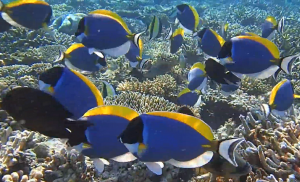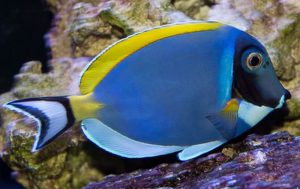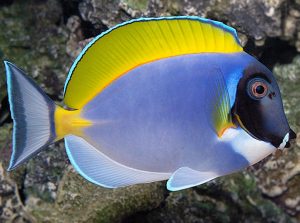The Powder Blue Tang (Acanthurus leucosternon) known to tropical fish keeping enthusiasts as the Powder Blue Surgeonfish is found throughout the shallow clear coastal waters of the Indian Ocean and ranges from eastern Africa to the Andaman Sea, southwest Indonesia, and from Christmas Island, into the western Pacific Ocean to Bali, Indonesia.
The Powder Blue Tang is a solitary dinural species that lives in the clear shallow waters of the reef flats and upper seaward slopes that surround the inshore coral reefs of their range, at depths to over 82 feet, where they feed on green macro algae, brown filamentous algae, benthic weeds, and small growths of algae among the crevices of reef rocks. Their small protruding snouts allow them to feed on the algae that grow in the crevices.
Although the Powder Blue Tang is aggressive with other surgeonfish and usually encountered singly; when there are plentiful supplies of food available, they will occasionally join up into large shoals and can be seen grazing together.
The Powder Blue Tang has an oval shaped laterally compressed body with a small snout and sharp small teeth that are used for grazing. It has a vivid powder blue to medium blue body color, with a black head and a broad pale blue to white band around it from pectoral fin to the throat, and a vivid yellow dorsal fin, thinly edged in black and blue, that ends at the base of the caudal fin. The pelvic and anal fins are white to pale blue and the crescent shaped caudal fin is white to pale blue outlined in black. Like all tangs, they have a sharp scalpel like spine at base of the caudal fin that they use for defense. Males are smaller in overall body size than females.
The Powder Blue Tang can be housed in a mature FOWLR or reef aquarium of at least 125 gallon capacity with a sand or crushed coral substrate, copious amounts of mature live rock for them to graze on and hide among, and plenty of free swimming space. They need a moderate amount of water movement in the tank and unlike most tangs, the Powder Blue Tang prefers water temperatures to be around 82˚F.
The Powder Blue Tang is entirely reef safe and will not bother corals, decorative clams, or invertebrates in the tank.
They are aggressive towards its own species and conspecifics, but peaceful towards other fish of the same or larger size. Never house them with aggressive triggerfish, Sohal Tangs, or other similarly aggressive tangs.
Acanthurus leucosternon must be the dominant fish in the system that you house them in.
Some good tank mates for the Powder Blue Tang include Clownfish, Damselfish, Angelfish, Dottybacks, Wrasses, Gobies, Cleaner Shrimp, Urchins, and Turbo Snails.
Although Powder Blue Tangs have been bred in an aquarium environment, their larvae have not been successfully reared. Because of their adult size and breeding habits, it is unlikely that Powder Blue Tangs can be successfully bred in an aquarium environment by the average tropical fish keeping enthusiast.
In the wild, Powder Blue Tangs are open water pair spawners that reproduce in large groups. Mated pairs appear to stay together even within large groups. When ready to spawn, the males change color to warn off rival males and attract females. When they are in a large school, a bonded pair will break away and rise upward toward the surface where they release their gametes. The small (.17mm diameter), spherical, fertilized eggs have a single oil globule to aid in their buoyancy and dispersal. Once hatched out, the small larvae remain in the planktonic stage for 42 to 68 days. When they are close to 1 inch in size, the small larvae settle out of the water column to the bottom where they feed on small microalgae among the seagrass and develop into juveniles.
Even if you happen to purchase a bonded pair and have an enormous tank with plenty of swimming depth, it is extremely difficult to replicate their breeding behavior.
In their natural habitat, Acanthurus leucosternon feed on green macro algae, brown filamentous algae, and benthic organisms. In a mature community aquarium environment they will eat meaty foods along with the other fish in the tank but should be provided with plenty of marine based seaweed and algae to reduce aggression, strengthen their immune system, and improve their overall health.
Spirulina Flakes, frozen Mysis shrimp
, and flake foods soaked in some type of vitamin supplement (Selcon or garlic) to ward off parasites is highly recommended. Dried seaweed offered on a veggie clip
or some Nori tied to a rock should be feed at least 3 times per week. Ocean Nutrition, Sea Veggies
, and Seaweed Salad are also ideal products that are very easy to use.
Because tangs produce much less body slime than other saltwater fish, they are often referred to as “dry skinned” fish. The lack of body slime makes them very susceptible to Cryptocaryon (saltwater ich) and other marine diseases.
The Powder Blue Tang (Acanthurus leucosternon) is readily available to tropical fish keeping enthusiasts at relitively reasonable prices from specialty fish shops and online wholesalers, retailers, and collectors at the following approximate purchase sizes: Small: 1-1/2″ to 2-1/2″; Small/Medium: 2-1/2″ to 3″; Medium: 3″ to 4″; Medium/Large 4″ to 5″. Depending on size and locale they are collected from they range in price from $70.00 to over $300.00.
Minimum Tank Size: 125 gallons
Aquarium Type: Reef or FOLR
Care Level: Moderately Difficult
Temperament: Semi Aggressive
Aquarium Hardiness: Moderately Hardy
Water Conditions: 74-83° F, dKH 8-12, pH 8.1-8.5, sg 1.020-1.025
Max. Size: 9.1″
Color Form: Blue, Black
Diet: Herbivore
Compatibility: Reef OK
Origin: Africa, Maldives, Sri Lanka
Family: Acanthuridae
Lifespan: Over 7 years
Aquarist Experience Level: Intermediate





